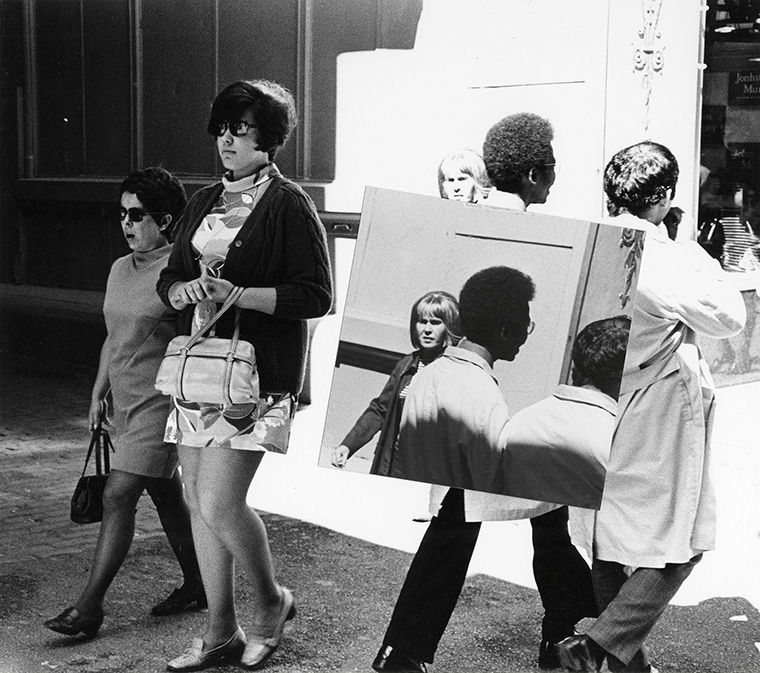Photographer turns Chicago into his dark room
Gitterman Gallery and Stephen Daiter Gallery
Kenneth Josephson, an 83-year-old photographer located in Chicago, has been regarded as one of the innovators of conceptual photography since the ‘50s.
May 9, 2016
Many millennials consider themselves photographers because they have an Instagram account with filters. But Kenneth Josephson, 83, has been a photography innovator since the ‘50s.
Josephson, born in Detroit and now a Wicker Park resident, is best known for his conceptual photography, a style staged to depict a certain idea, like a picture overlapping another object in the picture.
His work has been featured in the Smithsonian Institution in Washington D.C., the Metropolitan Museum of Art in New York City and the Art Institute of Chicago, where he was a professor for more than 35 years.
Though his work is primarily created in Chicago, he currently has an exhibit at the Gitterman Gallery in New York that runs through June.
“I was in a very high-power, creative environment that encouraged experimentation, and we could try anything we wanted as long as the result worked,” Josephson said of his experience when he first came to the city and enrolled at the Institute of Design in Chicago, part of the Illinois Institute of Technology.
Many of Josephson’s images show him holding a postcard of a scenic location, like in Sweden, Chicago or New York, overlaid on the same location.
“It was like going back to the scene of where the postcard was made, and usually, there was a time difference between the postcard and when I made my black-and-white photograph,” Josephson said. “It was like a representation of two moments overlapping in the same space and mixing time. The juxtaposition created a new, special relationship.”
Josephson said he was always able to capture interesting moments of daily life while living in Chicago because of the wide variety of people and places the city provided.
“[There were] endless things to photograph in Chicago,” Josephson said.
Josephson’s partner, Marilyn Zimmerwoman, said he still photographs to this day, most recently on April 28 before his book signing at the Robert Koch Gallery located in San Francisco.
“Everybody asks if Ken still photographs, and I can say he still lives to constellate his life around his work,” Zimmerwoman said. “He still packs a camera and film, and devotedly carries them with him.”
Tom Gitterman, owner of Gitterman Gallery, said his gallery only shows work the curators are “personally moved by.”
Josephson was a man whose work spoke for itself, Gitterman said. Because of that, he has had three exhibitions displayed at the Gitterman Gallery since 2008, according to Gitterman.
Gitterman said he admires Josephson for being a proponent of conceptual photography for more than 60 years.
He said Josephson has influenced generations of artists by following his intuition and allowing his personal experience to shine through his work.
“His work has a singular expression, and it stands out amongst other work within similar genres,” Gitterman said. “When artists try to work too hard to try to be different, they end up actually becoming more alike.”
Josephson’s book detailing his work entitled “The Light of Coincidence,” which was published earlier this May and is also on display through July at the Robert Koch Gallery located in San Francisco.
In addition to three exhibitions at the Gitterman Gallery, Josephson has also had three exhibitions at the Robert Koch Gallery, according to Ada Takahashi, one of the principals at Robert Koch Gallery. His work is already established in the art community, but the gallery wanted his audience to be broadened, she said.
“These works were providing a visual vehicle for the viewer to enter the image,” Takahashi said. “It also revealed his role as the image-maker without using any other papers or Photoshop—he was creating a collage.”
Unlike some artists, who can be aggressive in building their careers in the art world, Takahashi said Josephson has no interest in that.
“He’s a very modest and quiet individual,” Takahashi said. “He’s a passionate person who has been a bit under the radar. It’s really gratifying to see people gain a better understanding of the breadth of his work.”








